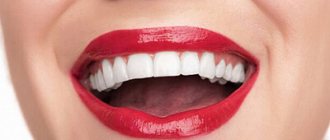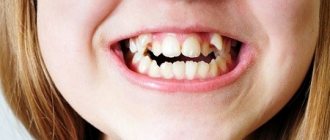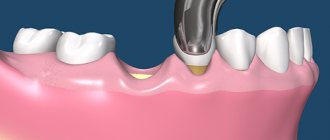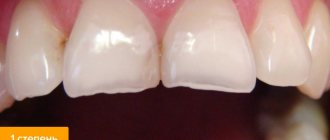Are your teeth too close together? Does this result in the formation of a dental arch shortened by several millimeters? Does this affect facial symmetry? Most likely, we are talking about crowded teeth. The problem lends itself to an effective orthodontic solution. If treatment is approached comprehensively, then in a few months the defect can be removed and you can boast of your beautiful and healthy teeth. What exactly should you pay attention to when treating dental crowding? Experts spoke about this.
What is crowded teeth in children and adults, and why does it occur?
Crowding of teeth is a common problem in which the dental units are located too close to each other, some crowns “overlap” the bottoms of the neighboring ones, forming an unaesthetic picture.
Teeth can be crowded in the middle, on the sides, and also in both the back and frontal areas at the same time. Most often, dentists diagnose crowding of the front teeth of the lower jaw.
There are three stages of dental crowding:
- Third or advanced, when the dental arch decreases in size by approximately 7 millimeters;
- The middle stage of dental crowding, when the row of teeth is shortened by 4 - 6 millimeters;
- Initial or first, when the size of the dental arch is reduced by 2 - 3 millimeters.
What is the difference between braces and aligners?
Both correctors are designed for the same task: they correct occlusion and make the dentition straight. The principle of operation of the structures is identical - moving dental units to a given point, but the similarity ends there.
- The bracket system acts on the dentition using locks and a tension arc, and the aligners create an impulse to shift the tooth with special activators.
- Braces are a non-removable system that is installed for the entire course of treatment, aligners are removable devices that the patient can remove and install independently.
- Orthodontic aligners do not interfere with your usual lifestyle and diet; when using braces, there are certain dietary restrictions.
- Maintaining the hygiene of biopolymer aligners is easier than cleaning a bracket system consisting of many elements.
- Elements of braces can injure the mucous membrane and interfere with closure; the functions of the tongue, created from elastic inert thermoplastic aligners, do not have these disadvantages.
- Locks with an arc are conspicuous (except for lingual systems); mouthguards made of transparent material are almost impossible to see from the outside.
When choosing aligners or braces to straighten your teeth, it is impossible to say for sure which will be better. Not in every clinical situation, mouth guards are the most effective, but they undoubtedly lead in terms of comfort. For each situation, the dentist will offer several treatment options, and the patient will choose the optimal one in terms of price, aesthetics and functionality.
Why do some people experience crowded teeth while others do not have the problem?
There are many reasons for crowded teeth. Let's list the most common ones:
- anatomically large teeth;
- large jaw from birth;
- “extra” teeth;
- wisdom teeth that were recommended to be removed, but were not removed after eruption;
- “bad habits” in young patients (thumb sucking, pacifiers, artificial feeding);
- breathing through the mouth, caused by ENT diseases, scoliosis, and other factors. Against the background of oral breathing, the child’s dental system is formed incorrectly;
- lack of minerals and vitamins necessary for the formation of healthy teeth;
- early removal or loss of baby teeth (for example, due to mechanical trauma).
Prevention
As preventive measures to somewhat minimize the risk of developing such an anomaly, we can recommend:
- regular dental consultations;
- control over the growth and formation of oral organs in children;
- getting rid of bad habits that provoke pathology;
- ensuring timely prosthetics in case of fairly early amputation of baby teeth;
- prevention of childhood rickets;
- proper and balanced nutrition, rich in calcium, vitamins and microelements.
Crowding of a number of teeth in a child - how to spot it in time and how to help?
Children's crowding of teeth, as a rule, occurs and is noticeable even at the stage of eruption of baby teeth. In the period from 4 to 6 years, when increased growth of the jaws occurs, a space (the so-called trema) is formed between the baby teeth, which is necessary for the eruption of permanent teeth. If the space does not form, it means that the eruption of the molars will be late, or there are other problems with the jaw.
It is important! During the period of eruption of molars, it is important to check the ENT organs and correct existing problems with posture, since these points are interrelated. Against the background of mouth breathing (and correct breathing through the nose), defects of the bite and jaw are formed, including crowding of teeth.
When diagnosing a tendency to crowding of teeth or true crowding of a row, the orthodontist recommends step-by-step treatment:
- wearing myofunctional trainers that will correct the position of the jaws and help align the dentition at the teething stage;
- myofunctional gymnastics exercises, which will help “pump up” the chewing and facial muscles, normalize muscle tone in this area;
- the use of corrective elements for teeth and jaws: plates, dental activators, palatal expanders, etc.
If crowded teeth are diagnosed in a teenager between the ages of 13 and 16, dentists may recommend the use of braces or aligners. In advanced cases, ligature braces are recommended.
What are braces?
A brace system is a non-removable orthopedic device consisting of clasps with grooves (braces), an arch that combines these clasps into a single mechanism, additional elements - elastics, ligatures, and an arch is passed through the grooves. The principle of operation lies in the ability of a metal arc to take its original shape. Straightening up, she pulls the locks behind her, pulling the teeth into the required position. The result is stabilized with fixed or removable retention devices.
Bracket systems differ in design - they are ligature, self-ligating, vestibular, lingual. They are made from a variety of materials: metal alloys (including gold), polycrystalline ceramics, synthetic sapphires. Devices made of metal have no equal in strength; the most aesthetically pleasing are ceramic and sapphire. When choosing which is better, aligners or braces for straightening teeth, you take into account not only the aesthetic side. The main thing to start from is the capabilities of the system in a particular case.
Can crowded teeth develop after wisdom teeth erupt?
Yes maybe. This is a fairly common picture when a person had relatively straight teeth up to a certain stage, but after the third molars came out, pronounced crowding began to be observed.
Crowding occurs as a result of the pressure of the wisdom tooth on the remaining teeth, the row moves, healthy teeth “find” each other, which is why they deteriorate.
The situation is aggravated if wisdom teeth come out on both the left and the right at the same time.
Crowding of the dentition can be observed even if there is room in the jaw for a wisdom tooth, and, moreover, it is inevitable if the “eights” are located abnormally.
To solve the problem of crowded units, wisdom teeth are recommended for removal. It is also better to remove the “eights” if the x-ray shows their incorrect position. These measures are recommended as prevention.
Why should you consider treating crowded teeth?
Many owners of densely growing teeth do not see them as a particular problem and do not consider it necessary to correct the situation. Meanwhile, dentists consider crowding to be a malocclusion pathology, which in the vast majority of cases requires correction.
It is almost impossible to properly clean teeth that are overlapping each other. After all, there are a large number of places in the oral cavity where it is difficult for a toothbrush to reach. They actively accumulate soft plaque, which is quickly converted into hard deposits, the so-called. tartar. Such patients need regular hygienic teeth cleaning with ultrasound and Air Flow much more often, and in the absence of professional care they are much more likely to develop dental diseases.
- Caries. Carious dental lesions in such patients are not always detected even during medical examinations. Without treatment, caries proceeds unnoticed and reveals itself already at the stage of acute inflammation. In this case, it is not always possible to save the tooth.
- Pathogenic microflora multiplying in dental plaque causes inflammation of the gums and other tissues surrounding the tooth - gingivitis and periodontitis. Inflammatory gum diseases can cause the loss of even healthy teeth even faster than caries.
- Chronic periodontitis can lead to the development of serious diseases - periostitis and a life-threatening abscess.
- With a long-term absence of a tooth, atrophy and loss of bone tissue is observed in this place. The pathology of the bite is aggravated and can lead to overload of the temporomandibular joint, and then cause disturbances in the functioning of other parts of the musculoskeletal system.
Can teeth crowding be treated with aligners?
Yes, such treatment is in demand. Aligners are aligners, a removable orthodontic device made of polycarbonate. A more aesthetic, but at the same time expensive alternative to braces. Aligners exert constant pressure on crowded teeth, provoking the natural resorption of alveolar bone tissue in the direction of tooth movement, while bone tissue is formed in the opposite direction. Thus, the crowded teeth move along a trajectory pre-planned by the orthodontist, and the crowding gradually goes away. Dental aligners are distinguished by their aesthetic appearance, compact size, easy to remove and put on, invisible on the teeth, and easy to care for throughout the entire treatment period.
Can crowded teeth be treated without braces?
Yes, treatment without braces is acceptable. If the patient does not want to get braces, or there are objective medical reasons for this, it is recommended to treat the defect using tooth separation. The lateral interdental areas are lightly ground at each edge. As a result, it is possible to obtain the previously missing three millimeters to straighten the dentition. Also, if teeth are slightly crowded, specialists may suggest installing veneers or lumineers. Dentists specialize in treating crowded teeth with braces, aligners, and other effective techniques. An integrated approach to solving the problem, maximum preservation of the health of your teeth, ideal results in a short period of treatment. Schedule a consultation today to enjoy a healthy, beautiful smile in no time.
Treatment methods
Modern orthodontic developments make it possible to successfully treat crowding. Based on the characteristics of the clinical picture of the pathology, one or another correction procedure may be indicated.
Braces
Most often, such treatment is justified when the form of the anomaly is not too serious.
The course of correcting the defect will take several months, if you follow all the specialist’s recommendations, the effect of the treatment is visible and lasting. For each patient, the time to use the systems is selected individually - it depends on the age group, the quality of the periodontal tissues, as well as the presence of concomitant diagnoses.
Various models of such structures make it possible to align the jaw row due to the formation of an oval of the correct shape formed by an arch. Thus, abnormally deployed organs are placed in the correct place.
The cost of the procedure varies in the following range: installation of the product from 20 to 60 thousand rubles, excluding the price of the braces themselves, since here the amount is determined by the material from which the structure will be made. Their minimum cost is about 14 thousand rubles.
Design features of metal and ceramic non-ligature braces, their advantages and disadvantages.
Here we will discuss the tactics and effectiveness of treating defects using T4K trainers.
Follow the link https://orto-info.ru/zubocheliustnye-anomalii/okklyuzii/glubokiy-prikus.html to figure out how to correct a deep bite in adults.
Tooth extraction
If there is insufficient free space in the jaw row, especially at the stage of advanced type of crowding, the patient has no choice but to resort to the removal of part of the organs. First, the outermost lateral teeth are amputated; they are also called wisdom teeth.
When the clinical situation is too advanced, sometimes even such a radical measure is not enough and premolars have to be removed.
This mainly concerns the lower jaw, since it is much more subject to deformation and mechanical pressure than the upper jaw. Due to this, its natural size becomes somewhat smaller over time, and with such a diagnosis, this is a rather aggravating factor.
Depending on the severity of the disease, the course of treatment can range from 2-3 weeks to 1.5-2 months. After removal of all necessary organs, the installation of orthodontic structures is indicated.
The cost of the removal procedure is standard and depends on the region, clinic and the cost of pain medication. The minimum price for amputation of one organ will cost the patient an average of 5 thousand rubles.
Separation
Such treatment will be effective only if the pathology is not very pronounced. It is carried out by slightly grinding down the enamel surface (mechanical principle of separation) or installing clearance spacers (physiological version of separation).
The first case is the opportunity to free up to 0.5 cm of interdental space.
It is worth noting that many experts consider separation as a completely worthy alternative to amputation of fragments of the jaw row.
The procedure is carried out quickly, sometimes 2-3 visits to the dentist are enough. The cost of the service is from 300 rubles for interdental separation of a single fragment.
Aligners
The devices are used for initial and moderate severity of the anomaly. With the help of aligners, treatment proceeds much slower (within 1 year), but this procedure is much more comfortable for a person.
The price of structures is several times more expensive than braces, but the effectiveness of such treatment is much higher.
The principle of eliminating the problem of crowding is to apply gentle but regular pressure on the jaw row. With the help of the habituation reflex, organ fragments are rotated into the correct position.
There is a psychological “memorization” of the desired position by the teeth, which is developed throughout the entire course of treatment and is gradually corrected with each subsequent replacement mouth guard.
Transparent and thin in appearance, they present no difficulty in wearing. The course of treatment is about a year. Their cost is determined by the complexity of the correction and the number of aligners that need to be made.
If there is overcrowding, about 40 units will be required; this service will cost the patient approximately 200-260 thousand rubles.
Expansion of the dentition using plates
Such manipulations are permissible only after an in-depth study of the qualitative condition of periodontal tissues. The doctor records the presence of the amount of hard bone tissue required for the procedure.
The manipulation itself is done using several methods, but most often plates are used. The effect is achieved by systematic pressure of the expansion plate on the jaw row, and gradually giving its fragments the correct position.
Products are made individually. The best results in this way were observed in children and adolescents, whose bones are not yet fully formed and are more susceptible to changes in position than in adults.
The design is standard - a plate, mounting screws and a metal spring. The devices are fixed with clasps.
The course of treatment depends on the situation. This is generally a period of 6 to 12 months.
Price – from 6,500 per unit, plus about the same amount of services for installation, control and subsequent removal of the device.
In the video you will find out whether it is possible to treat crowded teeth without braces.











